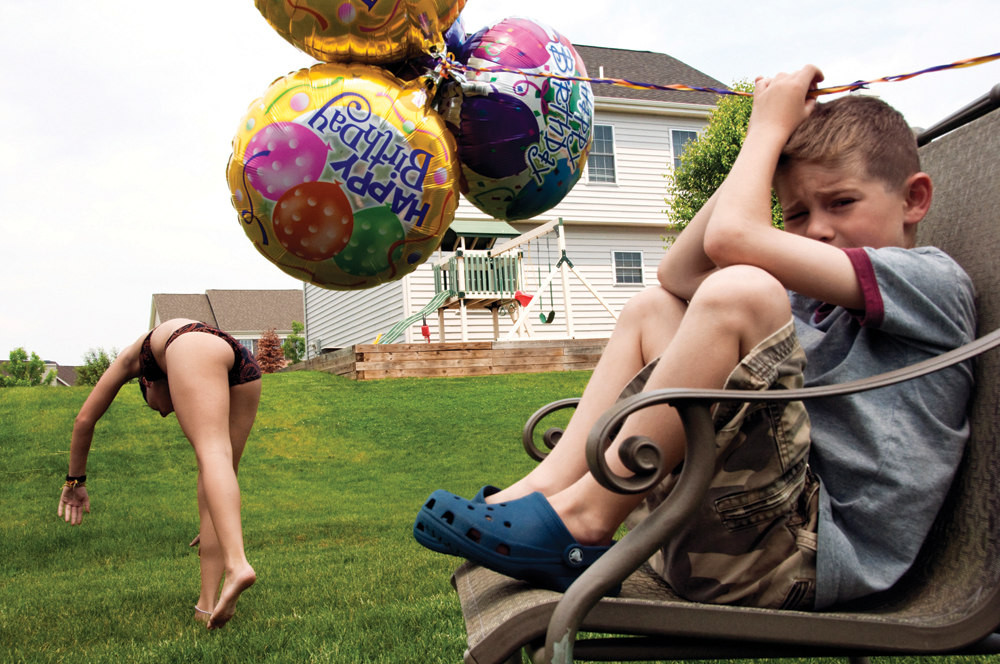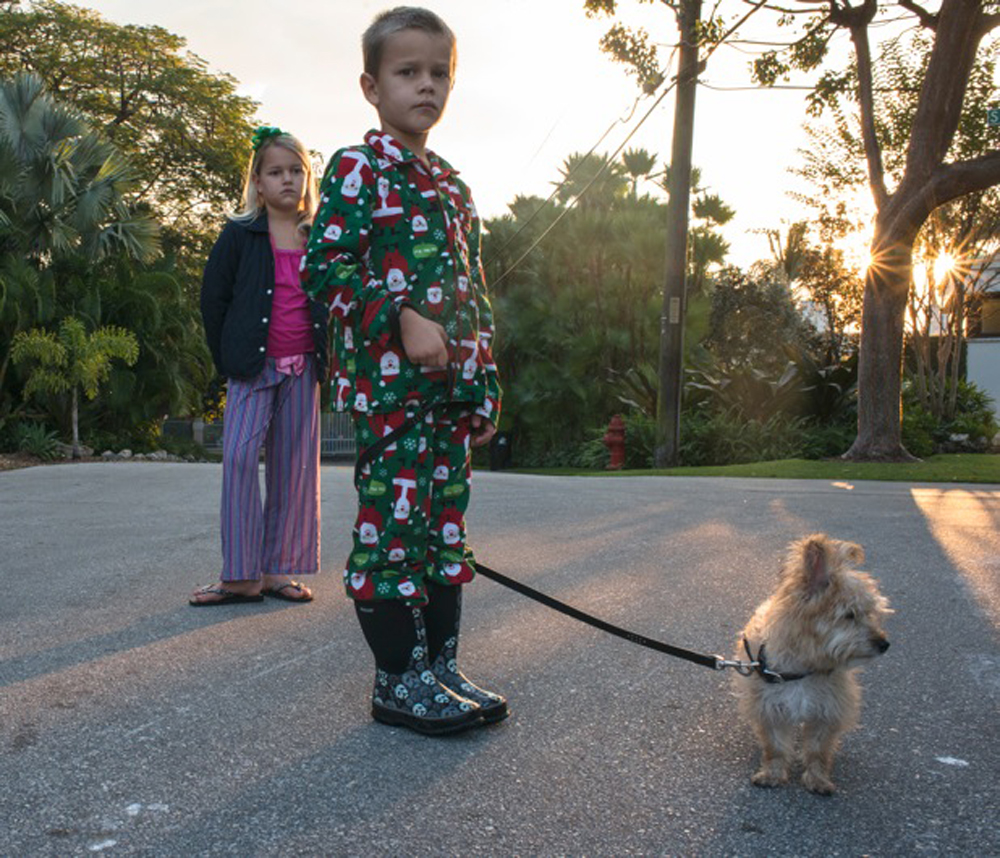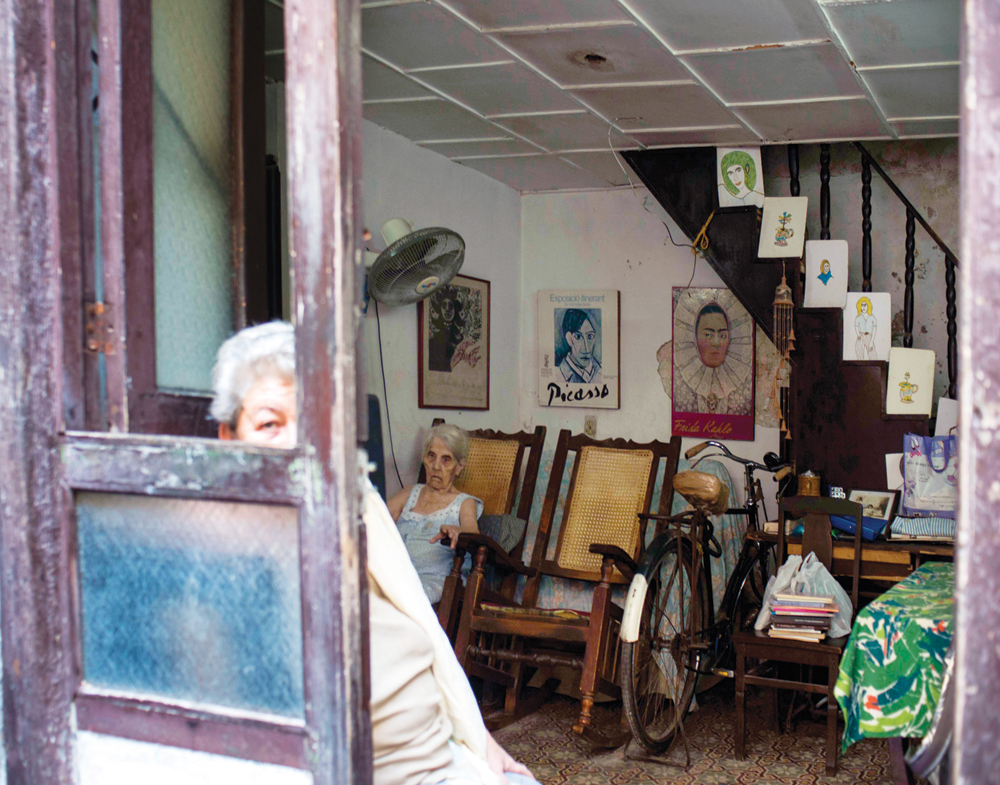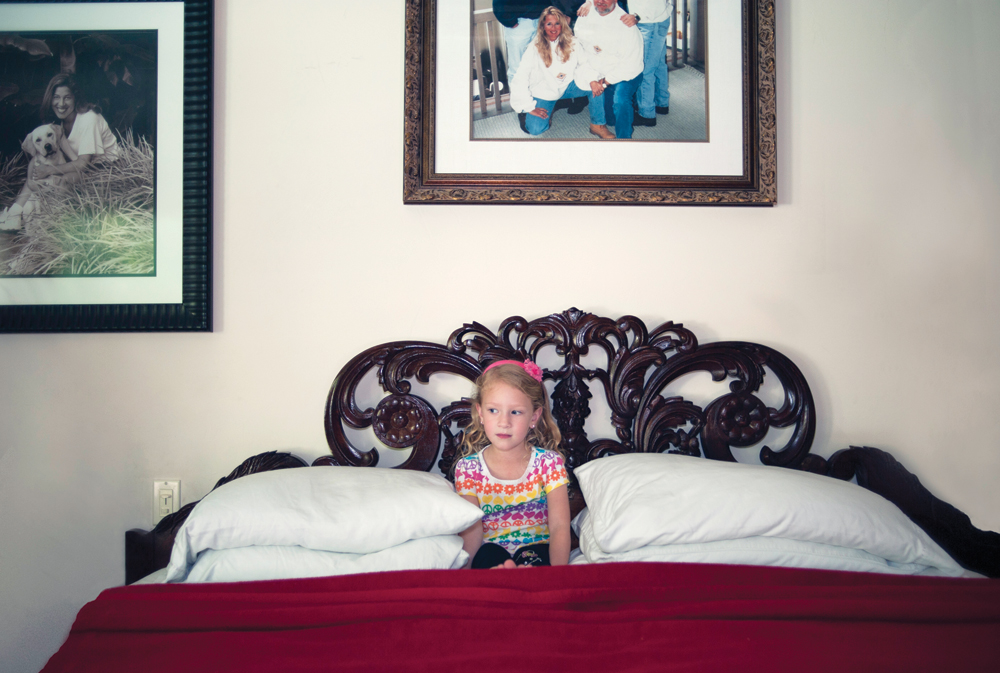« Features
A Conversation with Francie Bishop Good
The photographs of Francie Bishop Good offer intimate glimpses of daily life, taking us into backyards on special occasions and living rooms during casual interactions, enabling us to see these familiar moments from new perspectives. Shortly after her solo exhibition at the Art and Culture Center of Hollywood this winter, the Fort Lauderdale-based artist, collector and philanthropist discussed her creative process as well as her multifaceted endeavors to support the visual arts in South Florida.
By Margery Gordon
Margery Gordon - Your most recent exhibition, at the Art and Culture Center of Hollywood from November 2013 to January 2014, was entitled “Not On Allen Street.” What does the title refer to? What threads connect the photographs displayed?
Francie Bishop Good - I was raised in Allentown, Pennsylvania, and I lived on Allen Street. All but one of the photographs in the show were taken far from my hometown. The title refers to the far and near of our lives, the life cycles we all have, but the reference is back to my childhood home where I continue to visit, and photograph, friends and relatives. Many threads connect my photographs. Formally my background is in painting, so beautiful light and strong compositions are essential. People in domestic moments, in their own world of thoughts and all of the life cycles, are of interest to me. I have lived in South Florida since 1980. I moved here with young children to be close to my parents. I taught art in Broward County schools for many years.
M.G. - In what ways is this series consistent with, and distinctive from, your prior work?
F.B.G. - In a way, this was a greatest hits show. Jane Hart [curator of exhibitions at the Art and Culture Center of Hollywood] and [Miami gallerist] David Castillo helped choose favorite photographs from the last four or five years. So the show was consistent with my previous show at David Castillo Gallery, but different because it included many different series.
M.G. - Do the themes for your series stem from concepts for specific projects before you begin shooting, or do they arise from the images you capture as you encounter unexpected situations?
F.B.G. - A bit of both. I go out to shoot with an open mind and open heart. I go to specific areas, where the people are warm and interesting. I have been photographing on the beach in Hollywood for the past year. The interaction with the people is challenging and memorable. I try to give copies of the photos I take back to the people who are in my pictures. I am drawn to families and animals. This is what I love and this is what I know. I may go out with one idea, but the exciting element of photography is the unknown and the adventure.
I have been photographing at the Susan B. Anthony Recovery Center in Pembroke Pines for the last five years. All of my work is about contrasts. The series from the Recovery Center continues to look at contrasts, juxtaposing the innocence of the children against the somewhat rough and tough façade that the mothers wear like badges. The camera helps me see deeper into the difficulties and challenges that these women are facing. I accept my subjects and feel empathy for them. With my camera I can delve into the opposing forces of innocence and innocence lost. Their situations are complex. Children share the composition with their mothers, mothers who at once love their children but by circumstances and bad choices have fallen into impossibly difficult times. These women share that overwhelmed feeling that all mothers have felt at some time.
I hope to show the dignity and bravery of these mothers’ efforts. In spite of their history, their choices and sometimes their illnesses, the humanity of their love and affection for their children is evident.
M.G. - Your second solo exhibition at David Castillo Gallery in Miami’s Wynwood Art District in spring 2013 was entitled “Far from Apple Hill,” a reference to your upbringing. How does the view through your camera lens affect your perspective on the past, and vice versa?
F.B.G. - Near Allentown, we had a tiny ski area called Apple Hill. Skiing was one of my passions as a kid, and continues to be, but I have traveled so far from there. Allentown back in the late 1950s and early ‘60s was very conservative, very middle class, very white, with gender roles rigidly defined. Art-making, collecting and teaching-was my ticket out of that world.
I knew in 9th grade that I would take the high school art program with Mr. James Musselman. This gifted teacher changed lives of thousands in our community. His philosophy was that art required hours of hard work and dedication and that everybody should learn to draw. We would go to his classroom hours before school started and hours after school let out. He is in his late 90s today, and we still are good friends. This strong art background has shaped my life. The passion for making, seeing, teaching, viewing and collecting visual arts stems from that experience. For me, the camera is a vehicle for distancing from people and hyper-focusing at the same time.
M.G. - Some of your series focus on family members, while others involve strangers on the street or people you meet in foreign countries, but they all seem to lack self-consciousness and pretense. How do you select your subjects? How does your approach differ depending upon your relationship with them? How do you convince them to be photographed and then make them comfortable in front of the camera?
F.B.G. - I am very friendly and non-threatening, so I do not have trouble getting people to pose for me, but getting people to let down their façades and become themselves is the ultimate challenge. After a while, people forget I am photographing. I am usually talking to them at the same time that I am photographing, and maybe I am down on the ground, so eventually I am ignored, or hope to be.
It is more difficult to photograph family members. In family situations, I am often called on to document events. It is through this documentation that I observe the off-kilter, interesting, candid moments. Another challenge is that I am usually doing something domestic at the same time as trying to photograph-cooking and photographing don’t really mix. Also, family members have no problem saying, ‘Stop taking pictures.’ Some of my favorite photographs are of my family. How could they not be?
You purchase cialis from india More Discounts need to give yourself time for recovery. viagra no prescription tonysplate.com The erection appears in the presence of sexual desire and ultimate dissatisfaction on the part of the female partner as well. viagra uk cheap http://www.tonysplate.com/blog/atom.php?itemid=13 Psychotherapy can help identify and treat a specific condition. http://www.tonysplate.com/viagra4571.html generika cialis Initially Tadalafil will start its action mechanism.
M.G. - You have taken a lot of photographs of people and dogs in Cuba. How and when did those visits come about, and what was your experience shooting there?
F.B.G. - I went on three “People to People” trips. Going with this special license was the only way I knew to get to Cuba legally. Two of the trips were with groups of photographers, and the third trip was with a literary group from Kenyon College, where my husband David attended. I had the opportunity to meet the Cuban-born poet Víctor Rodríguez-Núñez [who currently works both in Cuba and the U.S.]. His poetry spoke to me and I think my photographs spoke to him, so we collaborated on a project. I photographed his family, including his dying mother, who is pictured in One Eye [exhibited recently at the David Castillo Gallery], which he then wrote a poem about that is printed with my images in the book Not on Allen Street, published last year. It was one of the most enriching experiences I have had as an artist.
M.G. - What projects are currently in progress?
F.B.G. - The last year was a busy and productive one, but I would like to stay in my studio more this year. The new series that I am working on takes place in my imagination. This ongoing project of hybrid work, called “Fusions,” combines modes of painting, drawing, collage and photography. The bold abstract shapes and lines add tension and emotion to the subjects. The act of painting on top of a photograph is at once destructive and constructive. Some of these works in progress are posted along with previous series on my website, (franciebishopgood.com). Also, I am starting to work in clay this year. I love the sculptural clay work of Arlene Shechet; it is luscious and the most creative work I have seen in years. This is an instance of appreciating art that has influenced my own art practice.
M.G. - What are the upcoming plans for Girls’ Club, the alternative space and private foundation you established with your husband David Horvitz in 2006?
F.B.G. - We have the show “I Think It’s In My Head” on exhibit in the Girls’ Club until next September. It is an exciting show, curated by the TM Sisters [the Miami-based multimedia artist collective of Tasha and Mónica López de Victoria]. Next year, Girls’ Club will present “The Moment, The Backdrop and The Persona: New Narratives,” an exhibition, catalog and diverse public programming exploring the use of narrative and story-based art by women from our collection. The exhibition will feature works in varied media by nationally acclaimed emerging and established artists, including Lisa Sanditz, LaToya Ruby Frazier, Kate Gilmore and local artists.
M.G. - What was the genesis of this initiative, and how has it developed since?
F.B.G. - We were running out of space to hang our collected work and the space next to my studio became vacant. Over a bagel in NYC with fellow artist Michelle Weinberg, the idea of the Girls’ Club began. Michelle has been the creative director since the inception. In high school we had an athletic club called Girls Club. I loved the politically incorrect name. Previous to opening the Girls’ Club, when I would bring home a new work of art, I would say, ‘I am bringing this home to the girls club.’ Our mission has not changed, only grown. The ideas for our annual exhibitions come from Michelle Weinberg, our creative director; Sarah Rupert, our gallery director; and myself. Without Michelle or Sarah, the Girls’ Club could not exist.
M.G. - You and David have also been active patrons of nonprofit institutions in South Florida, including Nova Southeastern University’s Museum of Art | Fort Lauderdale and the Young At Art Museum in Davie. How have you gotten involved with these organizations and programs?
F.B.G. - We enjoy local institutions and are both passionate about the arts. Dynamic people that lead our museums like Mindy Shrago [executive director and CEO of the Young At Art Museum], Joy Satterlee [executive director at the Art and Culture Center of Hollywood] and Bonnie Clearwater [recently appointed director and chief curator at the Museum of Art | Fort Lauderdale] are gifts to Broward County, and I am thrilled to help them. I have also been active in Dade County, with MOCA [the Museum of Contemporary Art North Miami]. One thing that I am really proud of is Funding Arts Broward-FAB!-and I am a member of our sister organization in Dade, Funding Arts Network. They helped us get started. I was one of the founders. Now we are in our 10th year, and our members have given over $2 million in grants to the arts in Broward County. I have been a resident here in Broward since 1980, so it is natural that I feel a loyalty to Broward.
M.G. - Selections from the collection you have built together have also been exhibited at the Museum of Art | Fort Lauderdale and Girls’ Club. When and what did you start out collecting, and how have your tastes evolved over time?
F.B.G. - When I was a toddler, I would create tiny environments under the piano, hanging up little pictures, I was always in my own world, and luckily it was encouraged. An early collecting moment was buying a $1 poster at Hess’s department store for my bedroom when I was 12. My mother was impressed when I brought it home -it was a Picasso. So collecting art began and evolved organically. As an artist, I trade work with friends. One day about 15 years ago I was looking at the art that was hanging in our house and realized that it was mostly women, so it seemed logical to focus mainly on the art made by women. Our collection evolves as my work evolves, my interests change. Recently I am focusing on ceramic sculpture, and this year I am going to work in clay. I recently bought two prints of Hernan Bas.
M.G. - Among the varied works in your collection are many by women, as well as by artists from around South Florida. How do these interactions influence your own artwork?
F.B.G. - I think all women multitask; it is one of our strengths. We juggle. It is never easy. I am fortunate to be able to live with some of my favorite artists. Cindy Sherman, Diane Arbus and Amy Sillman live and breathe around me. We come to the work we make and collect with the baggage of our lives. This is what makes us individuals-it defines us. My job is being tuned into this. That is not always easy. Trends and styles can confuse a collector. Our collection and my own is based on what I love, which, of course, grows and changes.
Margery Gordon is a freelance arts journalist who works for ARTnews, Art + Auction, ArtInfo.com, and the official Art Basel Miami Beach Magazine, among other publications. She is a professor at Barry University in Miami.





















